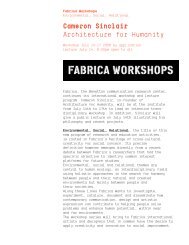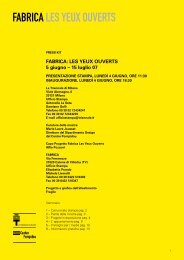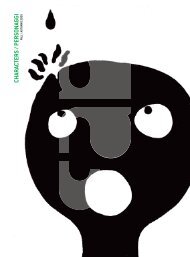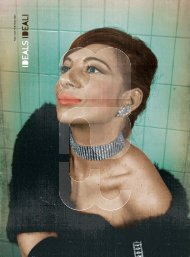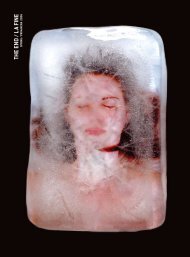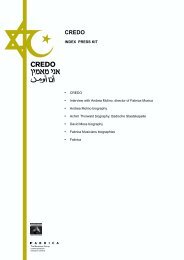F A B M A G A Z IN E / M A Y -J U N E 2 0 0 4 - fabrica
F A B M A G A Z IN E / M A Y -J U N E 2 0 0 4 - fabrica
F A B M A G A Z IN E / M A Y -J U N E 2 0 0 4 - fabrica
Create successful ePaper yourself
Turn your PDF publications into a flip-book with our unique Google optimized e-Paper software.
Namikon<br />
---------------------------------------------------------------<br />
Namiko reads a book 3 and smiles.<br />
Then she gets of the bus and hides her face under a white scarf<br />
so wide that it only leaves her eyes uncovered.<br />
Nakimo is thinking about a possible outline for a photo. Her<br />
eyes collect images of the world around her and select shapes<br />
and details.<br />
She has chosen photographs to tell stories. She shoots and<br />
paints her thoughts with a scientific and creative eye. She adds<br />
details to allow whole worlds to come to the surface.<br />
The first time I saw her hunting for a shot was on the bus to<br />
come from Treviso to Fabrica 4 . Today we are to meet so she can<br />
tell me about her work.<br />
We meet at the tables near the coffee machine.<br />
“Anything I read or anything that comes into my head has been<br />
transformed into images ever since I was little.”<br />
She was born in Japan but it was the Western culture of<br />
London and Milan that pushed her to regain possession of her<br />
culture of origin.<br />
After a few years as a fashion photographer, in a very cool<br />
atmosphere, in the vortex of photographic sets packed with<br />
assistants, she began a minimalist search that she<br />
continues today.<br />
---------------------------------------------------------------<br />
Now here pieces are image haiku, little thoughts that<br />
become poems 5 .<br />
“If I think about it I could say that I have gone through three<br />
periods. In the first I was a fashion photographer applying<br />
esthetic criteria taken from Caravaggio’s art or from museums<br />
that I visited.<br />
I like the encroachment of painting on fashion but also because it<br />
was through painting that my fascination with images began 6 .”<br />
She uses gestures while she speaks and shifts her weight from<br />
one foot to another as if she has too many things to say and<br />
not much time to say them.<br />
“I fled from Japan. I didn’t feel a part of Oriental culture and<br />
so at eighteen I found myself in London. Then something<br />
happened inside me.”<br />
She pauses for an instant and searches for the right words,<br />
she speaks both Italian and English well. To avoid being<br />
misunderstood she prefers to speak Italian with me. She<br />
pronounces ‘r’ and smiles.<br />
“The distance from Japan helped me rediscover it. I started<br />
to study and do research into its traditions and uniqueness.<br />
That was the beginning of my second period, much more<br />
minimalist and symbolic. My photos represent concepts<br />
and moods.”<br />
So the images started to change. Her photos are filled with<br />
strong symbolism. This was the word that she had been<br />
searching for these last few minutes: Symbolism.<br />
She seems small and defenseless behind the camera, but when<br />
it is time to shoot she becomes silent and professional, she<br />
starts on her subjects/ objects with the care of an anxious<br />
mother and you could spend hours watching her.<br />
Her and her work.<br />
---------------------------------------------------------------<br />
“Since I’ve been here my point of view has changed again.<br />
At Fabrica I opened my mind and began to relate to very<br />
concrete things. I have felt a strong moral need in my work,<br />
which I didn’t feel before.<br />
Now I need to deal with social realities. That’s why I started<br />
photographing the homeless in Bologna. I spent several days<br />
with them and listened to their stories.<br />
The shots were taken at the end, as a final result of my contact<br />
with them.”<br />
The tools are reduced to the essential, just the right light and<br />
some music 7 .<br />
“What do you want to work on now?”<br />
“This barrage of images to which we are subjected made me<br />
think about those who can’t see, to what happens in the mind<br />
of those who can’t see to believe. We can do it and we are<br />
completely dependent on objects and on their visual<br />
representation, but they can’t. Seeing is believing? Maybe they<br />
believe to see…I don’t know. I’m working on it. I’m thinking<br />
about it. For example I would like to understand what their<br />
houses are like. I will go and visit them, we will talk, I will stay<br />
with them and try to find the right trigger.”<br />
And I’m already thinking about how Nakimo’s next photos will<br />
look. I think that perhaps we could think about doing a<br />
project together 8 .<br />
I ask her if there is something else she would like to say and<br />
she seems sure when she says No.<br />
We say goodbye and I begin to transcribe the interview.<br />
A few minutes later I hear someone coming quickly up the<br />
stairs. I try to concentrate and ignore it but soon the tiny steps<br />
are accompanied by a voice.<br />
“There’s something else I want to say…”, I stop writing, turn<br />
around. Nakimo is out of breath.<br />
“There is something else I want to say! It’s about my family who<br />
has been a great influence on me since I was a child. My<br />
grandfather was a composer and my mother a singer.<br />
I would like to say that they have been very important.<br />
And that’s why I release with music, if I can, especially very<br />
loud music! Can you write that?”<br />
“I’ll write it, I’ll definitely write it.”<br />
“OK. Thanks. Thanks a lot.”<br />
Namiko walks away calmly. I start writing again.<br />
Namiko legge un libro 3 e sorride.<br />
Poi scende dall’autobus e caccia il viso sotto una sciarpa bianca<br />
così larga da lasciarle liberi solo gli occhi.<br />
Quello a cui Namiko sta pensando è il possibile delinearsi di<br />
una foto. I suoi occhi raccolgono le immagini del mondo che la<br />
circonda e selezionano forme e particolari.<br />
Ha scelto la fotografia per raccontare storie. Scatta e dipinge i<br />
suoi pensieri con uno sguardo scientifico e creativo. Inserisce<br />
dettagli per lasciare che mondi interi vengano a galla.<br />
La prima volta che l’ho vista a caccia di foto era sull’autobus<br />
per venire da Treviso a Fabrica 4 . Oggi ci dobbiamo incontrare e<br />
lei mi racconterà del suo lavoro.<br />
Ci vediamo ai tavoli vicino alla macchina del caffè.<br />
“Qualsiasi cosa io leggessi o mi venisse in mente si trasformava<br />
in immagini, già da quando ero piccola.”<br />
È nata in Giappone ma sono stati l’Occidente di Londra e di<br />
Milano a stimolarle la necessità di riappopriarsi della sua<br />
cultura di origine.<br />
Dopo qualche anno come fotografa di moda, in un’atmosfera<br />
very cool, nel vortice di set fotografici intasati di collaboratori,<br />
ha dato inizio a una ricerca minimalista che continua tuttora.<br />
---------------------------------------------------------------<br />
Ora i suoi lavori sono haiku di immagini, piccoli pensieri che<br />
diventano poesia 5 .<br />
“Se ci penso potrei dire addirittura di aver attraversato<br />
tre periodi.<br />
Prima si trattava di una fotografia di moda a cui però applicavo<br />
dei criteri estetici rubati dall’arte di Caravaggio o dai musei<br />
che ho visitato.<br />
Mi picciono le incursioni della pittura sulla moda , anche<br />
perché è dipingendo che ho cominciato ad appassionarmi<br />
alle immagini 6 .”<br />
Gesticola quando parla e sposta il peso da un piede all’altro<br />
come se avesse troppe cose da dire e poco tempo per farlo.<br />
“Dal Giappone sono fuggita. Non sentivo affatto la cultura orientale<br />
e così a diciotto anni mi sono trovata a Londra.<br />
Dopo è accaduto qualcosa dentro di me.”<br />
Si ferma un istante e cerca le parole giuste, parla molto bene<br />
sia l’italiano che l’inglese. Per evitare di essere franitesa con me<br />
preferisce usare l’italiano. Pronuncia le ‘r’ e sorride.<br />
“La lontananza dal Giappone mi ha aiutato a riscoprirlo. Ho<br />
cominciato a studiare e a fare ricerca sulle sue tradizioni<br />
e sulle sue specificità.<br />
Da lì è iniziato il secondo periodo, molto più minimalista<br />
e simbolista. Le mie foto rappresentavano concetti e<br />
stati d’animo.”<br />
Allora l’immagine inizia a cambiare. Le sue foto si impregnano<br />
di un forte simbolismo. Questa era la parola che stava cercando<br />
già da qualche minuto: Simbolismo.<br />
Sembra piccola e indifesa dietro all’obiettivo, ma quando si<br />
tratta di scattare si fa silenziosa e professionale, mette mano ai<br />
suoi soggetti/oggetti con la cura di una madre apprensiva e si<br />
potrebbero passare delle ore intere a osservarla.<br />
Lei e il suo mestiere.<br />
---------------------------------------------------------------<br />
“Da quando sono qui è cambiato un’altra volta il mio punto di<br />
vista. A Fabrica ho aperto la mente e ho cominciato a<br />
rapportarmi a cose molto concrete. Ho avvertito una forte<br />
necessità morale nei miei lavori, che prima non sentivo.<br />
Adesso ho bisogno di realtà sociali con cui confrontarmi, per<br />
questo ho cominciato a fotografare i senza dimora di Bologna.<br />
Ho passato qualche giorno con loro e ho ascoltato le loro storie.<br />
Gli scatti sono venuti alla fine, come il risultato finale del mio<br />
contatto con questo mondo.”<br />
L’ attrezzatura è ridotta all’essenziale, bastano la luce giusta<br />
e un po’ di musica 7 .<br />
“A cosa vuoi lavorare ora?”<br />
“Il bombardamento di immagini a cui siamo sottoposti mi ha<br />
fatto pensare a chi non può vedere, a cosa accade nella mente<br />
di chi non può vedere per credere. Noi possiamo farlo e siamo<br />
assolutamente dipendenti dagli oggetti e dalla loro<br />
rappresentazione visiva, ma loro non possono. Vedere per<br />
credere? Forse loro credono per vedere…Non so, ci sto<br />
lavorando, ci sto pensando su. Mi piacerebbe ad esempio capire<br />
com’è la loro casa. Andrò da loro, ci parleremo, starò lì con loro<br />
e poi cercherò di trovare degli scatti giusti. ”<br />
E penso già a come potranno essere le prossime foto di Namiko.<br />
Mi viene in mente che magari potremmo pensare a un progetto<br />
insieme 8 .<br />
Le chiedo se c’è qualcos’altro che vuole dirmi e sembra sicura<br />
dicendomi No.<br />
Ci salutiamo e inizio a trascrivere l’intervista.<br />
Dopo qualche minuto sento qualcuno che sale le scale, molto<br />
velocemente. Cerco di concentrarmi e fare finta di niente ma<br />
subito i piccoli passi in punta di piedi vengono accompagnati da<br />
una voce.<br />
“C’è un’altra cosa che voglio dire…”, smetto di scrivere, mi giro,<br />
Namiko ha il fiato corto.<br />
“C’è un’altra cosa che voglio dire! Riguarda la mia famiglia, che<br />
mi ha influenzata molto da quando ero bambina. Mio nonno era<br />
compositore e mia madre cantante.<br />
Vorrei dire che sono stati molto importanti. È per questo che<br />
scatto con la musica, se posso, anche a tutto volume!<br />
Lo puoi scrivere?”<br />
“Lo scrivo, lo scriverò sicuramente.”<br />
“Ok. Grazie. Tante grazie.”<br />
Namiko si allontana con calma. Io ricomincio a scrivere.<br />
///////////////////////////////////////////////////////////////////////////////////////////////////<br />
///////////////////////////////////////////////////////////////////////////<br />
///////////////////////////////////////////////////////////////////////////////////////////////////<br />
//////////////////////////////////////////////////////////////////////////<br />
///////////////////////////////////////////////////////////////////////////////////////////////////<br />
////////////////////////////////////////////////////////<br />
///////////////////////////////////////////////////////////////////////////////////////////////////<br />
//////////////////////////////////////////////////////////////////////////////////////<br />
3 She was reading “The afternoon that flowers fall” by Teru Miyamoto. If she had to recommend<br />
a novel she would suggest: “The Devil in the Flesh” by Raymond Radiguet. / 4 The bus is the<br />
one with a slash. It goes from Treviso to Catena di Villorba. Between 8.40 and 9.40 it is full of<br />
Fabricanti and a few Trevigians. / 5 Haiku is a type of poetry popular in Japan which has become<br />
more widely appreciated around the world over the last century. Haiku writers are challenged<br />
to convey a vivid impression in only 17 Japanese characters. / 6 When Namiko said this she was<br />
thinking about Lady Lilith by Dante Rossetti painted circa 1886. / 7 In the shower Namiko sings<br />
Qualcun qui m’ a dit que tu m’aimes ancore, by Carla Bruni. She redeems herself by suggesting<br />
you listen to Arabic and Irish music. / 8 We have already decided on a title for the project: Oltre<br />
la visione (Beyond vision). Often at Fabrica you have an idea and then talk about it with someone<br />
else. The sharing, contamination of different expressive mediums can turn an inspiration or an<br />
idea into something bigger and better.<br />
3 Stava leggendo “Il pomeriggio in cui i fiori cadono” di Teru Miyamoto. Se dovesse consigliare un<br />
romanzo direbbe: “Il diavolo in corpo” di Raymond Radiguet. / 4 L’autobus è l’uno barrato. Parte da<br />
Treviso e arriva a Catena di Villorba. Tra le 8.40 e le 9.40 è pieno di Fabricanti e qualche trevigiano.<br />
/ 5 L’Haiku è una forma di poesia diffusa in Giappone, che è diventata sempre più apprezzata in<br />
tutto il mondo a partire dal secolo scorso. Gli scrittori di Haiku si lanciano in una sorta di sfida<br />
poetica che consiste nel trasmettere un’impressione con appena 17 ideogrammi della scrittura<br />
giapponese. / 6 Quando Namiko ha detto questo, stava pensando a Lady Lilith di Dante Rossetti<br />
dipinto nel 1886 circa. / 7 Sotto la doccia Namiko canta Qualcun qui m’ a dit que tu m’aimes<br />
ancore, di Carla Bruni. Si redime consigliando di ascoltare musica araba e irlandese. / 8 Abbiamo<br />
già deciso il nome del progetto: Oltre la visione. A Fabrica può succedere di pensare a un’idea e<br />
poi parlarne con qualcuno. La condivisione, la contaminazione tra diversi mezzi espressivi faranno<br />
di un’intuizione o di un’idea qualcosa di più grande e migliore.<br />
-------------------------------------------------------------------------------------------------------------------------------------- --------------------------------------------------------------------------------------------------------------------------------------<br />
42 / 43



